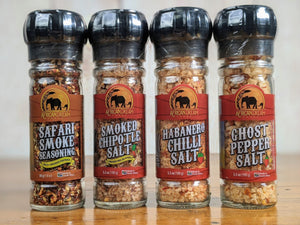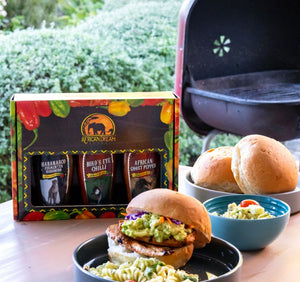Exploring African Sauces and Spices
Oct 26, 2022
African cuisine is rich and versatile, giving us a plethora of unique culinary experiences. We have flavors from North Africa, Southern Africa, Central Africa, Eastern Africa, and Western Africa. Still, some spices and sauces are common in many of them, and they surely create the most mind-blowing blends.
Sauces
Let’s take a journey through the different African sauce options and must-have condiments that’ll surely blow you away!

West African Pepper Sauce

Common in West Africa, African pepper sauce acts as a dipping sauce, condiment, or appetizer component, making it super versatile. The desired consistency is typically not too smooth and somewhat coarse.
The West African pepper sauce is almost a base for numerous Nigerian spicy dishes. You’ll usually find it alongside fish, boiled eggs, rice, noodles, pasta, yams, puff-puff (fried dough), and grilled meat.
The main ingredient in this hot and spicy sauce is, naturally, hot peppers, which could be scotch bonnet peppers, habanero peppers, Bird’s Eye chilies, and other hot peppers.
Other common West African pepper sauce ingredients are salt, ginger, vegetable oil, onions, garlic notes, red bell peppers, basil, Maggi, stock cubes, and a little vinegar. Also, you can add tomatoes to accommodate your spice tolerance and taste buds.
Last but not least, you can make the African pepper sauce in batches and store it in the fridge for about a week. A good tip is to add a thin layer of oil on top of the pepper mixture in an airtight container or a mason jar, sealing it off from the surrounding air. This way, it’ll remain good for 2 to 3 weeks.
Harissa

Harissa is another spicy and sour condiment from Tunisia, and it’s becoming more popular in North America. You can serve it in sandwiches or alongside couscous, sardine mzeouej, eggs, beans, lamb, beef, goat, and poultry. Additionally, you can use it to marinate chicken, fish, and lamb. Not to mention, you can add it to a soup or stew to give it extra flavor.
The Tunisian blended mixture requires roasted red peppers (or dried hot chilies) as their main ingredient. It’s also made with salt, mint, olive oil, cumin, garlic, coriander seeds, and caraway seeds.
Piri Piri

Piri Piri is a spicy sauce created by Portuguese settlers from Mozambique or Angola, the history is a bit murky. It’s popular in South Africa, Australia, and Canada. The unique name comes from the Swahili word Pili Pili, meaning pepper. The pepper used is also called bird’s eye chiles, birds eye chili, dried bird eye chili, and bird’s eye chilli.
This is the condiment to try if you want to test your spice tolerance! With only a hint of the pepper mixture, you can give your meal the needed heat and a savory taste. You can also rub it on chicken and meat. Another option is to season trinchado with it, a spicy beef dish.
To make this dish, you can combine peri-peri peppers, lemon peel, onions, black pepper, paprika, red wine vinegar, garlic, lemon, chili pepper, vinegar, oil, tarragon, oregano, citrus peel, and more. Or simply buy a bottle of Peri-Peri sauce and slather it on everything – make sure you grab an authentic South African one!
Shitto

Shitto means “pepper” in the Ga language. So, it’s a Ghanaian hot chili condiment served as a hot and spicy sauce with many traditional dishes, including fish and meat dishes, steamed white rice, green vegetables, fried plantains, and eba and waakye (which is a dish containing rice and beans).
Its main ingredient is hot chile peppers. The African sauce may contain vegetable oil, ginger, garlic, prawns, spices, crustaceans, and more. And you can either make it with tomatoes, onions, fresh peppers or oil, dried shrimp, and dried peppers.
Piments Ecrasés

Piments Ecrasés, which refers to crushed chili in Mauritian Creole, is a smooth paste found in Mauritius.
To make this hot sauce, mix the onions, chilies, and crushed ginger to create the spice paste. Then, add white vinegar to a small saucepan, then add some oil. Let it come to a simmer and then add in the paste.
You can stir-fry it in oil to suck the moisture out of it and elongate its shelf life. Afterward, you can serve it with a Mauritian dish! As for its ingredients, the African sauce has green or red chili peppers, crushed ginger, onions, vegetable oil or olive oil, and white vinegar.
Chermoula

Another North African sauce we have for you today is Chermoula, found in Morocco. It’s a rough paste that people typically serve on top of fish or seafood to give them more flavor. Another way of cooking with Chermoula is to use it as dressing for salads or seasoning for meat and vegetables.
As a sauce, it’s made of garlic, onions, cilantro, chilies, parsley, paprika, salt, saffron, pepper, lemon juice, olive oil, coriander, cumin, and chili peppers.
Filfel Chuma

If you’re looking for a Libyan hot sauce, Filfel Chuma might be it. It’s overpowering and fiery. But the best part of Filfel Chuma is its malleability, as you can control the heat level by adjusting the spice amount to accommodate your spice tolerance.
The sauce goes perfectly well with rice, eggs, beans, fish, and over-grilled meats. You might want to add it to hummus and yogurt or use it for salad dressing. Not to mention, Fiflel Chuma is excellent for seasoning vegetables, such as brussels sprouts, broccoli, asparagus, and cauliflower.
As for its ingredients, they include garlic, cumin, salt, oil, caraway, bell peppers, sweet paprika, cayenne pepper, and lemon juice.
Dongo-Dongo

Gabon brings us Dongo-Dongo, a sauce, soup, and distant relative of the famous Cajun-Creole gumbo. After all, gombo is the most used Central African word for Okra, and this is almost an okra soup.
Dongo-Dongo is the constant companion of Okra and may or may not be served with fish or meat. You might also find it served with starchy foods, including fufu, rice, Baton de Manioc, and chikwangue.
Now, how do you prepare the African sauce? As you’d expect, Okra is the main ingredient. Other ingredients are hot peppers, onions, garlic, Maggi, and bouillon cubes. You sautée these and add water. Then, mix the smoked fish, dried fish, or salted fish with the tomato paste.
Footi

If you visit Guinea, you might come across footi sauce. It’s also popular in Senegal. This sauce is essentially a stew that’s rich in tomatoes and Aubergine. Footi is traditionally served with rice, meat, or fufu, a traditional Guinean staple.
At its core, footi is an African sauce consisting of water, onions, eggplants, kidney beans, tomato sauce, and a bouillon cube. Let them slowly simmer for around three hours to get the desired consistency.
Spices
Each African spice brings something unique to the table (literally), so let’s look at some of the main ones.

Grain of Paradise
Grain of Paradise goes by many other names, such as the alligator pepper and Aframomum melegueta. This aromatic spice is the seed of the Melegueta pepper plant and is native to West Africa. Also, its spice has a percentage of about 0.5 to 1% essential oil. Not to mention, it has a mix of peppery, pungent, and fruity flavors.
Grain of Paradise is used to season myriad dishes. It can also replace black pepper and give your dishes a more complex flavor. For instance, you can add it to spice cakes, spice rubs, gingerbread, braises, stews, curries, chilis, pulses, tomato paste, and more. Other uses include cultural ceremonies, so you’ll find it used in baby naming ceremonies.
Berbere
We bring you this traditional spice blend from Ethiopia and Eritrean that gives traditional dishes their kick. Berbere is a mix of dried spices. It isn’t the hottest of spices but has a sweet, citrusy flavor and a bright red color.
You’ll find it in Ethiopia’s national dish, chicken stew, and stews made with vegetables or legumes. Not to mention, you can use Berbere to rub meat before you fry or grill it. And you can season cauliflower, kale, or vegetable-based dishes with it.
As for Bebere’s key ingredients, it contains ground ginger, fenugreek, and red chili peppers. The African spice might contain cinnamon, peppercorns, cumin, allspice, cloves, cardamom, coriander, long pepper, koramima, ajwain seeds, and nigella seeds.
Ras El Hanout
Fresh from the African cuisine, we have Ras el Hanout. The Arabic word means ‘head of the shop,’ but it’s understood as the top of the shelf. After all, you can’t have a Morrocan grocery shop without Ras el Hanout!
The African spice complements rice, couscous, pasta, and slowly cooked stew. And we can’t forget the mouthwatering flavor of lamb burgers and roasted chicken when you season them with this spice.
Ras el Hanout is a blended mixture of salt, coriander, cumin, cinnamon, cardamom, clove, ginger, black pepper, chili peppers, allspice, fenugreek, and more. This blend can be the product of combining over 50 distinct African spices!
Duqqa (Dukkah)
Duqqa is an authentic Egyptian coarse blend containing herbs, spices, and toasted nuts. Egyptians use it to season vegetables and meats. Otherwise, they mix it with olive oil to create a dip for bread and other foods. They may also add it to cheese.
Originally, Duqqa was viewed as peasant food, sustaining people throughout the day with its high fat and protein content.
But what is Duqqa made of exactly? It contains cumin, nuts, sesame seeds, hazelnuts, coriander seeds, almonds, pine nuts, salt, pepper, and pistachios. The use of these crushed nuts is what gives Quqqa its rough texture. In fact, the Egyptian Arabic word “Duqqa” comes from the verb “to crush” or “to pound.”
Cloves
Cloves are some of the most commonly used African spices. They’re made from the dried buds of the clove tree, no surprise there.
Organic cloves come with a particular taste and incense, which is why they’re used in the perfume industry. They have a tinge of sweetness mixed with bitterness, astringency, and heat.
When you cook meats, prepare sauces, or make stews, cloves can make them flavorful, and we can say the same for veggies, rice dishes, and soups. Last but not least, you might want to experiment with cloves in desserts, such as eggnog and pumpkin pie spice!
Cumin
Cumin is another spice that grows in Africa and is frequently used in its cuisines. Ground cumin goes by many names, including cumin seasoning, spice, and powder.
Interestingly enough, cumin has its cultural significance. After all, legend says that if the bride and groom carry cumin seeds during their wedding ceremony, they’ll be blessed with a life of joy and luck.
People use it to prepare soups, cook couscous and tajine, and season vegetables and meats. It also has some medical uses, such as treating coughs and colds.
Now, let’s talk about a particular type of cumin. Alnif Cumin is named after a village called Alnif, where cumin grows extensively. However, the plant is originally from Asia. What you get to work with is the dried leaf and powder created by crushing the grains.
Chiles
Chiles is a trademark of African cuisines. So, if you’re delving into African cuisine, you might want to make friends with the spice. Dried chili peppers are used as is or made into a powder. Additionally, you can rehydrate them with hot water.
There are various types of dried peppers, including aji Amarillo chiles, aji paprika chiles, aji Panca chile, Byadgi chile, Calabrian chiles, and organic New Mexico chiles.
Garlic Variations
Garlic is used a lot in African cuisines. It may have a smooth sandy texture or a more granulated one. You can also roast granulated garlic to get a sweet and mild flavor instead of the usual savory garlic. But if you want the most texture, you’ve got to go with minced garlic. All of these variations are typically added to the meat.
Organic Ajwain
Ajwain is found in African, Middle Eastern, and Indian cooking. The spice is a mix of earthy, minty, and bitter tones. Its dominant taste means that it’s only used in small quantities.
You can add it to meat, soups, rice, sauces, chicken, fish, beans, and bread. Additionally, Ajwain is used for medicinal purposes. You can boil it in water to help digestion and weight loss, reduce bloating and gas, and treat peptic ulcers and some sores.
Za’atar
Za’atar is a popular Middle Eastern spice, especially prevalent in Egypt. Its unique and versatile flavor is one you’ll want to savor, boasting a mixture of citrus, bitterness, and sweetness. After all, it isn’t every day that you come across a spice that you can rub on meat and sprinkle on popcorn!
Not to mention, za’atar is great for seasoning chicken, yogurt, eggs, cheese, and more. You’ll want to try za’atar in flatbread, tahini, salads, and hummus.
When it comes to the spices in the ingredients, you make it by combining various dried herbs and spices. We’re talking thyme, salt, sumac, marjoram, dried oregano, sesame seeds, dried dill, caraway seeds, and dried orange zest.
Why You Should Use Sauces In Your Everyday Cooking?
- There are multiple functions of sauces. Firstly, they can be used as a garnish, to brighten up a dish.
- Secondly, you can add a sauce to contrast the flavor of your recipe, so it might give a bland meal a hint of sharpness or tanginess.
- Thirdly, you can make a dish more flavorful by highlighting its flavor by adding more depth.
- Fourthly, sauces can make your food look good, giving it a coat or gloss.
Is the West African Pepper Sauce Super Spicy?
Yes, the African hot sauce is a very hot sauce due to its main ingredient, hot peppers. Sometimes, people use scotch bonnet or habanero peppers. However, you can tone it down by using one pepper or take out the spiciness altogether by using red bell peppers instead.
What Can You Do With Your Dried Chili Peppers?
- You can use them in their dried state, crush them into a powder, or rehydrate them with hot water. Then, you can add the rehydrated peppers to a food processor to make a peppers puree. This is a tasty condiment to serve with tacos, sandwiches, and hamburgers.
- But if you want to use whole dried peppers, you can add them to soups or stews and simply fish them out before serving
Final Words
Overall, each African sauce has its distinct texture, ingredients, taste, and spice level, but they make an excellent addition to numerous recipes. Sometimes, they may add flavor to soups and stews, be used to marinate chicken wings or meat, or be served as must-have condiments.
Many of them have some spiciness, which means that chili peppers tend to be their main ingredient. Regardless, the world of African sauces is flavorful, and you certainly don’t want to miss out on them!




